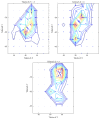Select and Cluster: A Method for Finding Functional Networks of Clustered Voxels in fMRI
- PMID: 27656202
- PMCID: PMC5021913
- DOI: 10.1155/2016/4705162
Select and Cluster: A Method for Finding Functional Networks of Clustered Voxels in fMRI
Abstract
Extracting functional connectivity patterns among cortical regions in fMRI datasets is a challenge stimulating the development of effective data-driven or model based techniques. Here, we present a novel data-driven method for the extraction of significantly connected functional ROIs directly from the preprocessed fMRI data without relying on a priori knowledge of the expected activations. This method finds spatially compact groups of voxels which show a homogeneous pattern of significant connectivity with other regions in the brain. The method, called Select and Cluster (S&C), consists of two steps: first, a dimensionality reduction step based on a blind multiresolution pairwise correlation by which the subset of all cortical voxels with significant mutual correlation is selected and the second step in which the selected voxels are grouped into spatially compact and functionally homogeneous ROIs by means of a Support Vector Clustering (SVC) algorithm. The S&C method is described in detail. Its performance assessed on simulated and experimental fMRI data is compared to other methods commonly used in functional connectivity analyses, such as Independent Component Analysis (ICA) or clustering. S&C method simplifies the extraction of functional networks in fMRI by identifying automatically spatially compact groups of voxels (ROIs) involved in whole brain scale activation networks.
Figures









References
LinkOut - more resources
Full Text Sources
Other Literature Sources
Miscellaneous

